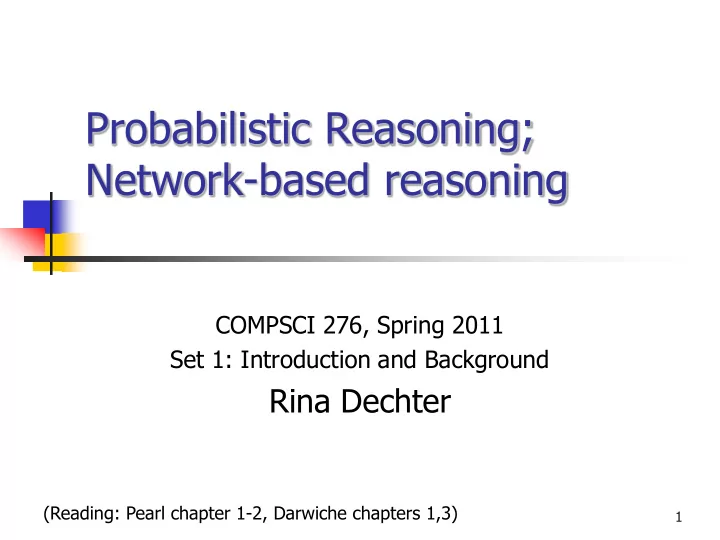

Probabilistic Reasoning; Network-based reasoning COMPSCI 276, Spring 2011 Set 1: Introduction and Background Rina Dechter (Reading: Pearl chapter 1-2, Darwiche chapters 1,3) 1
Class Description Instructor: Rina Dechter Days: Tuesday & Thursday Time: 11:00 - 12:20 pm Class page: http://www.ics.uci.edu/~dechter/courses/ics-275b/spring-11/ 2
Example of common sense reasoning Explosive noise at UCI Parking in Cambridge The missing garage door Years to finish an undergrad degree in college 3
Shooting at UCI Fire- shooting crackers noise Vibhav Anat call call Stud-1 call Someone calls 4
Why uncertainty Summary of exceptions Birds fly, smoke means fire (cannot enumerate all exceptions. Why is it difficult? Exception combines in intricate ways e.g., we cannot tell from formulas how exceptions to rules interact: A C B C --------- A and B - C 5
The problem All men are mortal T All penguins are birds T True … propositions Socrates is a man Men are kind p1 Birds fly p2 Uncertain T looks like a penguin propositions Turn key – > car starts P_n Q: Does T fly? Logic?....but how we handle exceptions 6 P(Q)? Probability: astronomical
Managing Uncertainty Knowledge obtained from people is almost always loaded with uncertainty Most rules have exceptions which one cannot afford to enumerate Antecedent conditions are ambiguously defined or hard to satisfy precisely First-generation expert systems combined uncertainties according to simple and uniform principle Lead to unpredictable and counterintuitive results Early days: logicist, new-calculist, neo-probabilist 7
Extensional vs Intensional Approaches Extensional (e.g., Mycin, Shortliffe, 1976) certainty factors attached to rules and combine in different ways. A B: m Intensional , semantic-based, probabilities are attached to set of worlds. P(A|B) = m 8
Certainty combination in Mycin A x If A then C (x) z C D If B then C (y) If C then D (z) y B 1.Parallel Combination: CF(C) = x+y-xy, if x,y>0 CF(C) = (x+y)/(1-min(x,y)), x,y have different sign CF( C) = x+y+xy, if x,y<0 2. Series combination… 3.Conjunction, negation Computational desire : locality, detachment, modularity 9
The limits of modularity Deductive reasoning: modularity and detachment P Q P Q P Q P K P K and P ------- ------ K Q Q ------ Q Plausible Reasoning: violation of locality Wet rain wet rain Wet Sprinkler and wet -------------- ---------------------------- rain rain? 10
Violation of detachment Deductive reasoning Plausible reasoning P Q Wet rain K P Sprinkler wet K Sprinkler -------- -------------------- Q rain? 11
Burglery Example Burglery Phone Alarm call Earthquake Radio A B A more credible IF Alarm Burglery ------------------ A more credible (after radio) B more credible But B is less credible 12 Issue: Rule from effect to causes
Extensional vs Intensional Extensional Intensiona l Uncertainty=truth value Uncertainty = modality Connectives combine certainty Connectives combine set of weight worlds Rules = Procedural license = Rules = constraints on the world summary of a problem solving = summary of world knowledge history 13
What’s in a rule? A B (m) P(B|A)= p A and B C (m+n-mn) C B (n) A B (p) Semantic difficulties: Semantic clarity: Handling exceptions, Syntax mirrors world knowledge Retracting conclusions Empirically testable parameters Unidirectional references Bidirectional Inferences Incoherent updating Coherent updating Computational merit: Computational difficulty: Locality+detachment Actions must wait verification of relevance 14
Probabilistic Modeling with Joint Distributions 15
Alpha and beta are events
Burglary is independent of Earthquake
Earthquake is independent of burglary
31
32
33
Example P(B,E,A,J,M)=? 34
35
36
37
38
Bayesian Networks: Representation P(S) BN Θ) Smoking (G, P(C|S) P(B|S) Bronchitis lung Cancer CPD: C B D=0 D=1 0 0 0.1 0.9 0 1 0.7 0.3 P(X|C,S) P(D|C,B) 1 0 0.8 0.2 X-ray 1 1 0.9 0.1 Dyspnoea P(S, C, B, X, D) = P(S) P(C|S) P(B|S) P(X|C,S) P(D|C,B) Conditional Independencies Efficient Representation 39
Recommend
More recommend